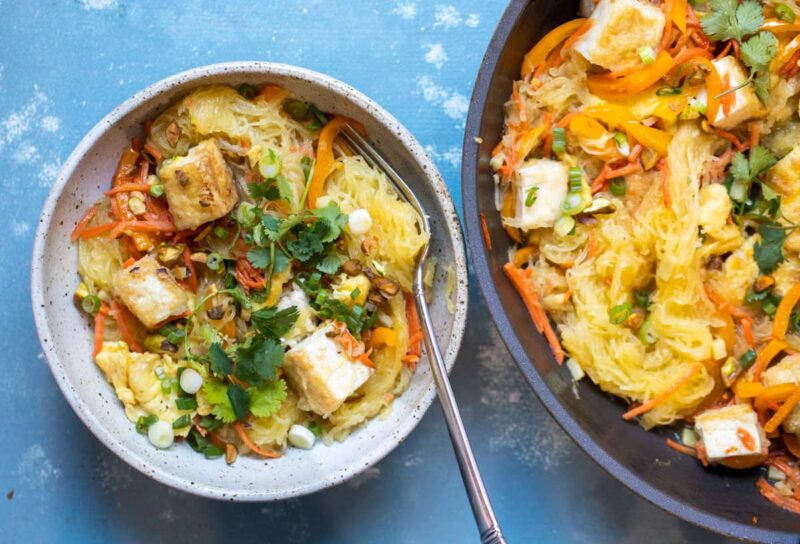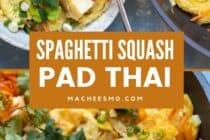I truly love using spaghetti squash in interesting dishes and this Spaghetti Squash Pad Thai is a wonderful dish that really doesn’t lose much from the traditional noodle. The flavors are all still really good and you can use a wide range of proteins and veggies to round out the stir fry.
While I made my own pad thai sauce for this version, you can also find pretty decent store-bought pad thai sauces these days and can make this recipe easier by using one of those sauces.
All-in-all, this spaghetti squash pad thai is truly a 30-minute meal and is very healthy and filling! Dig in!
Traditional pad thai noodles vs. spaghetti squash
Traditionally, pad thai is made with rice noodles. I’ve had it with thin rice noodles and thicker rice noodles. The rice noodle is sturdy and holds up to the sauce and other add-ins in the stir fry.
Obviously, subbing those with spaghetti squash changes up the dish slightly. The texture of the noodles is not the same, but the flavors are actually close. if you are a die-hard pad thai fan, you might judge this substitution, but I found it to be really good, especially if you are looking for a low-carb option to the pad thai.
How to prep spaghetti squash
You can either roast or microwave the spaghetti squash to prepare it for a dish like this pad thai. I chose the microwave on this particular day just because it’s a little faster.
To make it, chop the spaghetti squash in half and scoop out the seeds. Then poke some holes in the flesh of the squash and place it, cut-side down in a microwave-safe dish with some water in the bottom. Microwave the squash on high for 12-15 minutes total. I recommend doing it in 5 minute bursts and checking the squash after each time.
The squash is done when it is fork tender. It’ll be very hot so let it cool off before trying to shred it.
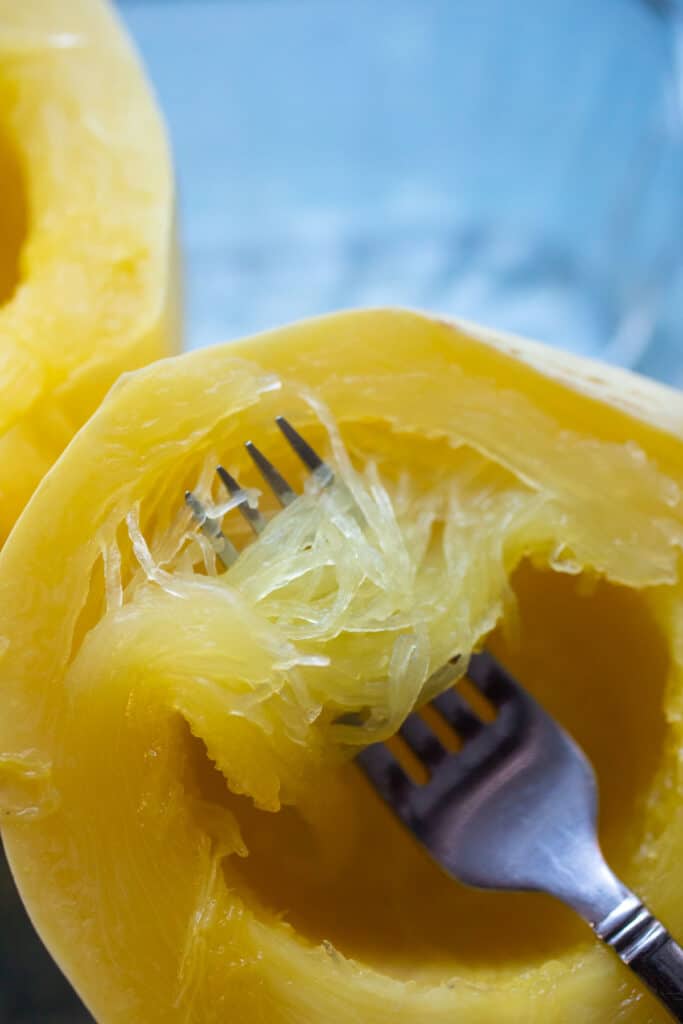
After the squash is cooled, you can shred it with a fork into long strands that resemble noodles. They are more delicate than noodles so keep that in mind. You don’t want to over-mix or over-stir them or they will start to break down.
Ingredients and vegetables for pad thai
There are some pieces of a good pad thai that you’ll need to make it at home.
- Protein. You’ll want to think about a protein or two for the pad thai. I used sauteed tofu on this particular day, but you could also use chicken, pork, shrimp, or a mix of things.
- Sauce. Pad thai sauce makes the dish. Check out the info below on making it at home if you can’t find a good sauce in the store.
- Egg. A signature piece of pad thai is a scrambled egg that gets mixed into the stir-fry. I like to keep my egg in larger chunks, but I’ve seen it really scrambled into tiny bits as well.
- Vegetables. You can go crazy here, but bean sprouts, red peppers, carrots, and aromatics like ginger and garlic are standards.
- Garnishes. I love garnishing pad thai and you can use your imagination. Cilantro, lime, and peanuts are standard, but there are other options for nuts and herbs that work well.
Making the pad thai sauce
Pad Thai sauce isn’t hard at all assuming you can find tamarind concentrate or paste. It isn’t a normal ingredient at US grocery stores, although you might get lucky. You’ll probably have to venture to an asian or latin grocery store where they usually carry tamarind in some form.
Personally, I like to use the concentrate if possible since it’s easier to stir into sauces, but the tamarind paste works fine as well. If nothing else, you can find the concentrate on Amazon.
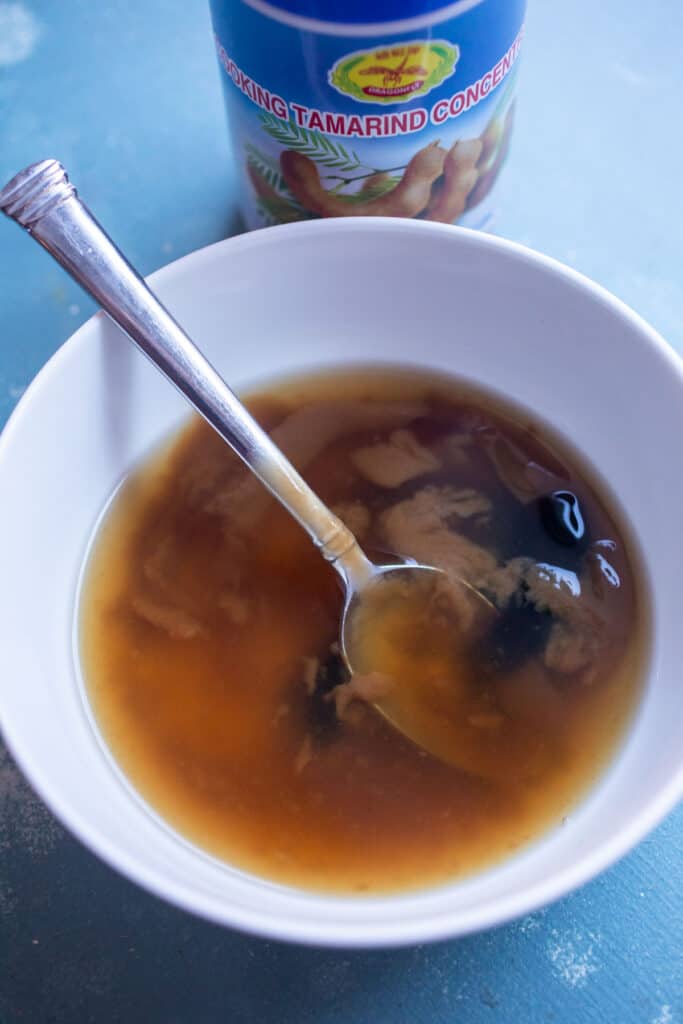
Once you have that tricky ingredient, then you just stir all the other ingredients together. Fish sauce, Oyster sauce, Honey, and some water to thin it all go in the sauce. You can taste it and adjust to your liking, of course. It’ll be pretty strong on its own, but remember it gets mixed in with the stir-fry so strong is good.
Finishing the spaghetti squash pad thai
Once you have the sauce and spaghetti squash done for this pad thai, the rest of the stuff comes together very quickly.
I’d recommend cooking a few of the items on their own to make sure they are cooked correctly. If you are using tofu, toss it with a little cornstarch and cook it in oil over medium heat until it’s crispy on the sides, maybe 4-5 minutes on two sides.
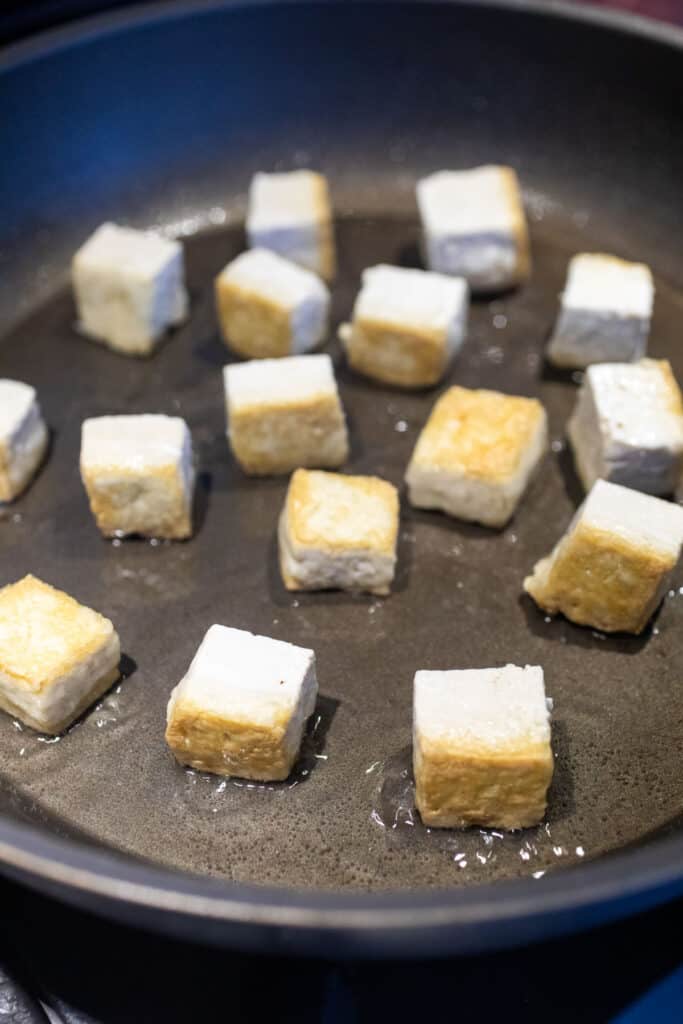
Remove the tofu and set aside and add the scrambled eggs. Let them cook until mostly set and then cut into cubes. Remove those from the skillet or wok.
Add a fresh drizzle of oil and add the rest of your vegetables including red peppers, carrots, and anything else you are using. Cook until the vegetables soften, maybe 3-4 minutes. Then add the tofu, eggs, and the shredded spaghetti squash.
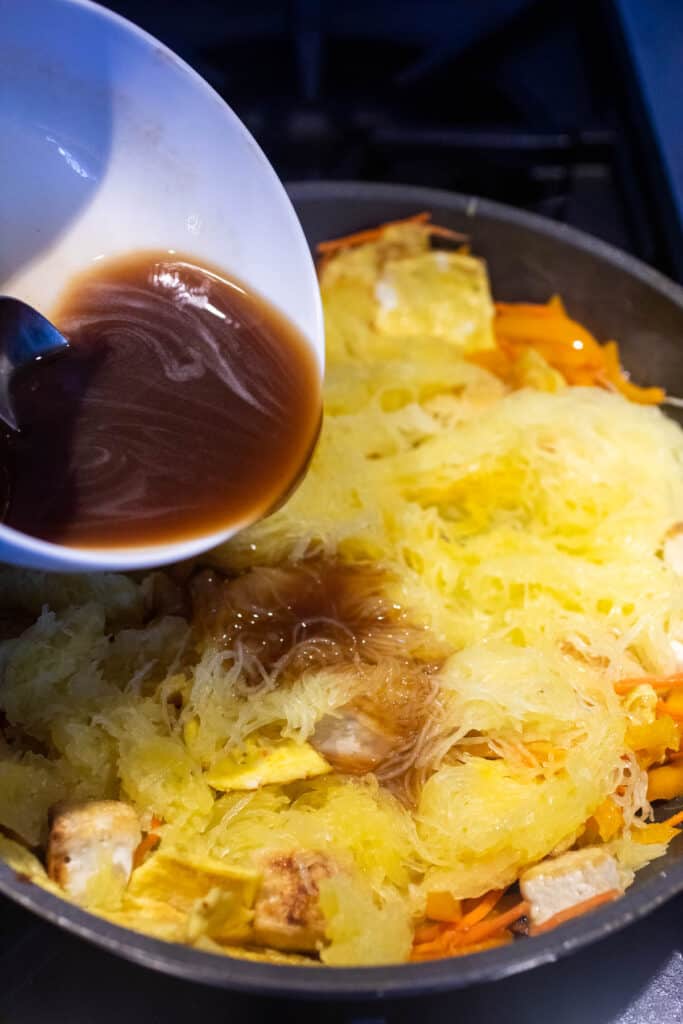
Finally, add in the pad thai sauce. I’d recommend starting with 3/4 of the sauce and maybe adding more if you feel like it’s too dry.
Toss the dish to combine everything well and then transfer to serving plates or bowl. Try not to stir the spaghetti squash noodles too much or they will fall apart.
Garnish the plate with chopped peanuts, cilantro, and lime wedges.
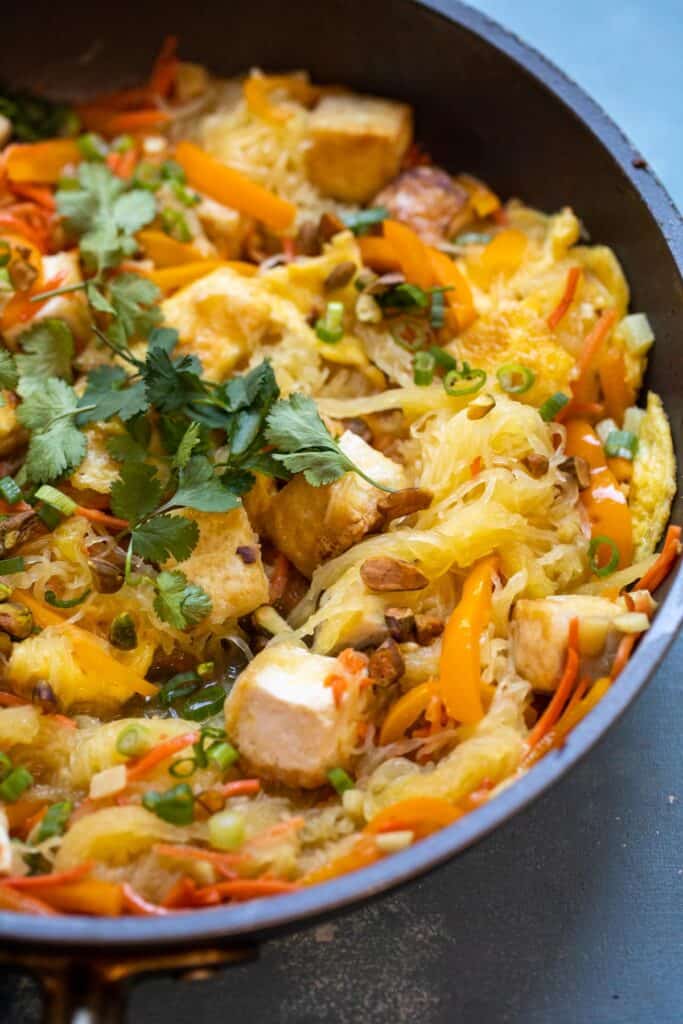
Storing and reheating this recipe
This spaghetti squash pad thai keeps and reheats pretty well for a few days. Reheat it gently on the stove top with a splash of water until warmed through or you can microwave it for 30-second bursts until it’s hot.
Substitution ideas for this pad thai
The great thing about pad thai is its flexibility. Once you have the sauce down and the base down (spaghetti squash), the rest is kind of up to you. I use dishes like this as a fridge-cleaning recipe and add all kinds of proteins and veggies to it depending on what I’m trying to get rid of.
Here are a few ideas.
- Substitute chicken, pork, or shrimp for the tofu for a protein alternative.
- Use traditional rice noodles instead of the spaghetti squash. Soak them well and then boil them until tender. Don’t overcook them or they will get mushy.
- Make the pad thai spicy by adding thai chilies or jalapeno peppers to the stir fry.
This delicious Spaghetti Squash Pad Thai has big flavors and is gluten-free and dairy-free so it can be adaptable to many different diets. It’s healthy, but the flavors are excellent and the dish works great as a dinner or lunch option.
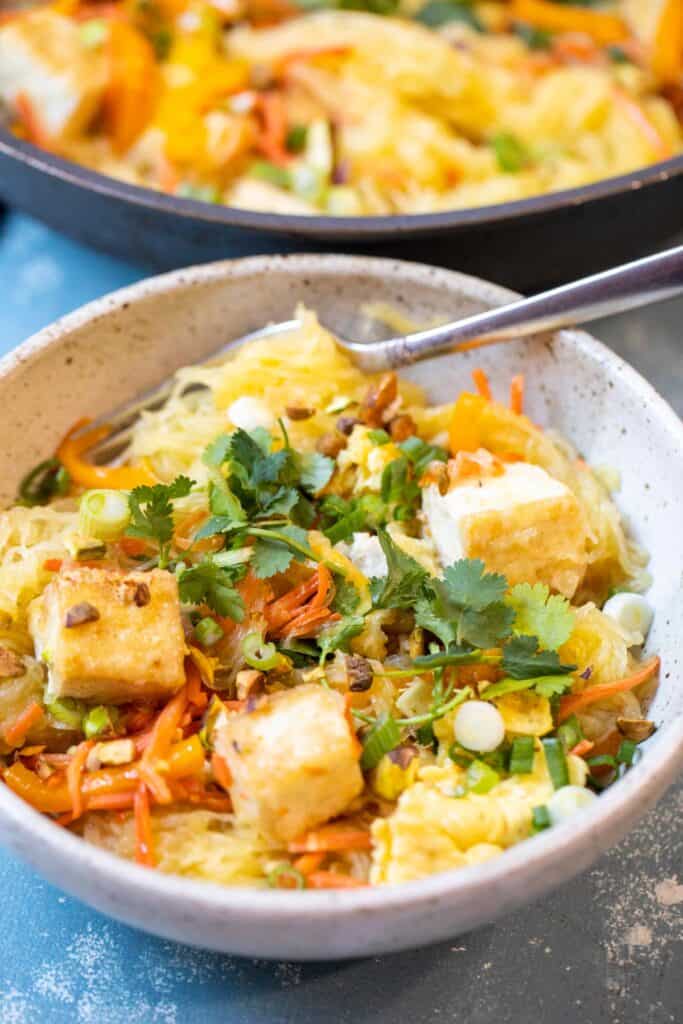
Spaghetti Squash Pad Thai
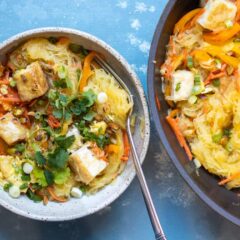
Ingredients
- 1 large spaghetti Squash, microwaved
- 14 ounces tofu, cubed
- 1 tablespoon cornstarch, for dusting
- 2-3 tablespoons vegetable oil
- 1 inch chopped ginger
- 1 orange/red pepper, chopped
- 1 cup shredded carrots
- 2 large eggs, scrambled
- ¼ cup chopped Peanuts
- Cilantro, garnish
- Lime wedges, garnish
Sauce:
- 2 tablespoons tamarind
- 2 tablespoons fish sauce
- 2 tablespoons honey
- 3 tablespoons water
- 1 tbsp oyster sauce
Instructions
- For spaghetti squash, cut the squash in half and remove seeds. Poke a few holes in the skin and place cut-side down on a microwave safe bowl. Microwave until fork tender, 12-15 minutes. Let cool and then use a fork to gently shred the flesh into long strands.
- For sauce, whisk together ingredients.
- To start pad thai, add oil to a skillet over medium heat. Toss tofu cubes in cornstarch and cook until crispy on two sides, 4-5 minutes per side. Remove.
- Add a fresh drizzle of oil and add the eggs. Let the eggs set and then cut into 1-inch cubes. Remove from skillet.
- Add a fresh drizzle of oil to the skillet. Add ginger, peppers, and carrots. Cook until softened, 3-4 minutes. Add protein and eggs and spaghetti squash. Top with sauce and toss to combine. Serve immediately garnished with cilantro, peanuts, and lime.

